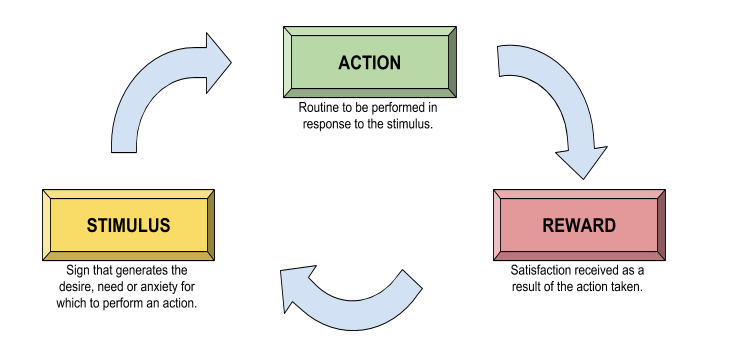By Jose Meyer – Project Manager at Santex
Want to give up smoking? Lose weight? Maybe start a course or embark on a career you’ve always had a passion for? These are some of the promises we make to ourselves, usually at the beginning of a new year.
We have renewed hopes, enthusiasm, and joy! But it usually isn’t enough, and many of these desires remain unresolved. It has been said that only 8% of people meet or achieve the self-imposed goals and resolutions they make, whether made at the beginning of a new year or at some other point during the year.
One of the causes of this lack of follow-through can be attributed to the lack of establishing habits that allow us to do what is needed or, on the contrary, to quit the habits that don’t allow us to move forward.
A habit is made up of three parts:
-
- The stimulus or signal we receive to do something.
-
- The routine or activities we do.
- The reward we receive for having completed those activities.

Identifying these components is a great first step toward being able to start implementing a new, good habit or to break an old, bad habit.
In hist book “7 Habits of Highly Effective People,” Stephen Covey summarizes years of study and research on the habits that we need to incorporate to improve our efficiency in both our professional and personal lives.
Habit 1: BE PROACTIVE
Complaining, blaming the government, blaming our parents or other people about our fate is very characteristic of REACTIVE people. These people live their lives according to the circumstances that surround them, or given certain conditions.
On the other hand, PROACTIVE people are conditioned by their own decisions. They take responsibility for their actions and accept the consequences of what they have decided to do.
A reaction occurs when a stimulus is received. Human beings have the FREEDOM to choose their answers. Proactive people put that freedom to use.
To create an analogy with the IT world, the materialization of this habit would be the recognition of ourselves as the PROGRAMMERS of our lives.
Habit 2: START with the GOAL in MIND
The creation process is made up of two parts; all things are created two times. The first creation is the mental creation, which is followed by the materialization – the physical creation. Habit two is about mental creation, visualization.
This habit refers to the creative process of imagining what we want to be, where we want to go. This is the time when we imagine what the result will be of the activities we want to carry out.
Following the analogy from the IT world, this habit refers to designing or creating the PROGRAM of our life.
Habit 3: FIRST things FIRST
When someone asks us what the important things in our life are, most of us would say health, family, friends, and work matter the most. However, in the practice of our daily routines, we do things that do not go according to what we think or want it to be.
For example: We say that health is important, but we do not dedicate time to exercising, and/or we continue to consume unhealthy foods. We say that family and friends are important to us. However, we do not always dedicate the time necessary to preserve, understand, or make those relationships grow. In the work environment, we often do not dedicate the time needed to renew ourselves and continue learning in order to keep ourselves up to date.
The third habit refers to defining priorities in all the areas of our lives and in all the roles that we as human beings must fulfill (parents, spouses, children, brothers, professionals, friends, neighbors, etc).
The relationship between “the urgent” and “the important” is raised with this principle. We should make time for the things that are “important and not urgent.” These are the things we plan based on what we want to develop in our lives and, as a result, we should dedicate less time to the “not urgent – not important” or “not important – but urgent.”
To end the IT analogy, this habit refers to EXECUTING the designed program. It has to be executed based on the priorities we have designed.
Habit 4: Think WIN – WIN
This habit is about seeking mutual benefits. We should share profits, knowledge, recognition, etc., especially in those relationships that we are interested in maintaining over time.
“Think Win-Win” is not an easy task. In general, we are prepared for the Win – Lose type of relationship. If the other wins, that means that we lose. We should stop believing that.
Thinking win-win requires the extra effort and creativity to look for mutually beneficial alternatives and solutions.
Habit 5: Search to UNDERSTAND First, BEFORE Being UNDERSTOOD
Most people listen to respond, but we do not listen to understand, and that is a big issue.
There are different levels of listening – each one depending on the degree of attention we pay to what the other person is telling us. In order to understand, we should develop what is known as “Empathic Listening,” which consists of putting all of our attention and intention into trying to understand what the other person needs to express to us.
For example, in the case of the development of a new product, the listening would need to happen before manufacturing the new product in order to understand the needs of our future consumers. In essence, it is to get out of our own way of thinking and into the shoes of the other person.
It is similar to the fact that to be able to provide a prescription, a doctor must diagnose the patient. This means he/she must understand what is happening to us.
This habit responds to a deep and perhaps unconscious human longing to feel understood.
Habit 6: SYNERGY
This habit is based on creative cooperation. Synergy suggests that through the collaboration of a group of people, we can obtain greater and better results than working individually. “Everything is greater than the sum of its parts.”
Something very interesting about this habit is that it raises the differences between people. Not only should these differences be accepted, but they should also be VALUED. Strength is obtained from differences and not similarities.
Two people with 10 years of work experience working together at the same time, sharing knowledge, have in fact 20 years of experience. There may be five primary colors, but by combining them we can obtain many more colors.
Synergy requires developing common objectives and a sense of mission: “Neither your idea nor mine, but an improved common idea.”
Habit 7: SHARPEN THE SAW
This principle refers to the renewal and continuous improvement of the body, mind, and spirit, social relationships (friends, family, neighbors, etc) and emotional relationships (relationships with ourselves). This well-applied habit generates or allows the development of the other six habits. Basically, it states that we must keep in mind the objective of continuously improving.
Although the concept of sharpening the saw refers to the integral improvement of ourselves, we can take an example of what happens in the world of software development. It is well known that one language or framework can become obsolete in a couple of years, and if programmers do not update themselves, they also become obsolete. This leaves them with less employability in the labor market.
CONTINUITY OF MATURITY
The first three habits refer to the private victory and are habits that are achieved individually: be proactive; start with the goal in mind and prioritize.
The following three habits refer to the Public Victory: Think Win-Win, seek to understand before being understood and to synergize. These are habits that involve the relationships with other people.
To achieve the Public Victory, the author indicates that private victory should be achieved first. With the private victory we achieve the “Independence” that basically refers to being responsible for ourselves, our actions, and their consequences.
With the public victory we achieve the “interdependence” needed to achieve, improve, and grow through our relationships with other people.
With both victories, we leave aside the “dependence” of other people who rule over the state in which our life is located.

Reference:
- The 7 Habits of Highly Effective People, Stephen Covey, 1989





